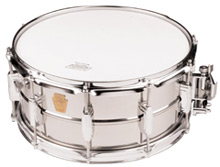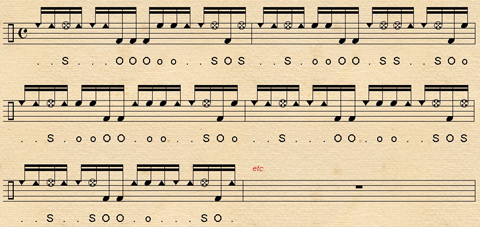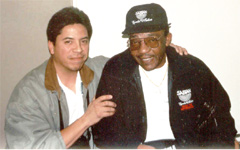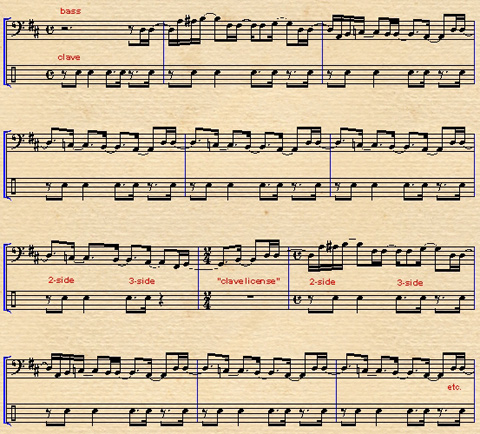Indice - Table of contents
New Stuff[hide]
Musicos: Rafael Paseiro Monzón
Musicos: Dennis Nicles Cobas
Musicos: Jiovanni Cofiño Sánchez
Musicos: Yasser Morejón Pino
Fotos: Tom Ehrlich : 2024 Monterey Jazz, P...
Resenas: Vacilón Santiaguero (Circle 9 ...
Staff: Bill Tilford
Fotos: Tom Ehrlich : 2024 Monterey Jazz, P...
Fotos: Tom Ehrlich : 2024 Monterey Jazz Fe...
Fotos: Tom Ehrlich : testing 123
Grupos: Pupy y los que S... : Discography - 1995- F...
Reportes: From The St... : Cubadisco 2...
Reportes: From The St... : Jazz Plaza ...
Fotos: Tom Ehrlich : Irakere 50th Annivers...
Photos of the Day [hide]
The Roots of Timba - Part II - The Clave and the Backbeat


Before entering the polyrhythmic labyrinth of Tu decisión cuál es, let's step back and consider the possibilities that were available to Changuito and Formell as they created their unprecedented fusions of Cuban and North American dance rhythms.
If the most essential element of Cuban rhythm is the clave, in North American music it's the backbeat that's constant across virtually all genres: 50s rock, blues, Motown, James Brown, punk rock, heavy metal, folk rock, country & western, rap, techno, etc. The Norteamericanos subdivide the beat in many ways and at many tempos, but you can always count on the snare drum, or some similar timbre, to be slamming out every 2nd and 4th beat.
Here's the most obvious way to combine the backbeat and clave:
0xx0 xxx0 xx0x 0xxx 3-2 rumba clave
xxxx 0xxx xxxx 0xxx backbeat
... or, leaving out every other backbeat:
0xx0 xxx0 xx0x 0xxx 3-2 rumba clave
xxxx xxxx xxxx 0xxx backbeat of the 2-side
At a normal dance tempo, a backbeat drumset groove fits the clave like a glove, as demonstrated by this crazy mix of Aretha Franklin's Rock Steady and LVV's Te pone la cabeza mala.
Changuito and Formell went beyond the obvious and created striking new rhythms by doubling or halving the tempo of the borrowed North American drum part. For example, if the drums play in half-time against the clave, the snare switches from hitting every backbeat to hitting every other downbeat.
1xxx xxxx 2xxx xxxx 3xxx xxxx 4xxx xxxx slow tempo
xxxx xxxx 0xxx xxxx xxxx xxxx 0xxx xxxx snare
1xxx 2xxx 3xxx 4xxx 1xxx 2xxx 3xxx 4xxx fast tempo
Here's a MIDI example to demonstrate:
0xx0 xx0x xx0x 0xxx 0xx0 xx0x xx0x 0xxx 3-2 son clave
Kxxx xxKx Sxxx xxxx Kxxx xxKx Sxxx xxxx backbeat (half-time)
S=Snare - K=Kick
Here's an example from the song we're about to study: Tu decisión, cuál es.
... and three songs we've already covered: Resuelve, La Habana joven and Llegué llegué.
Orlando Fiol points out that this particular flavor of double-time experiment may be the genesis of the unusual way the snare is used in Pupy's band of the 2000s, which, although it doesn't experiment with layered tempos, also tends to play the snare on the downbeat of the 2-side.
2002 - Pupy y Los Que Son Son - Qué cosas tiene la vida[source]
bass: Rafael Paceiro; drums: Bombón Reyes
(rhythmic concept attributed to Changuito)
0xx0 xxx0 xx0x 0xxx 3-2 rumba clave
xKxx KxKx SxxK xxxx kick and snare
x0x0 x00x 0x0x 0x0x
xxxx xxxx 0x0x 0x0x bass
To be complete, let's see what happens if we double the tempo of the backbeat groove:
0xx0 xxx0 xx0x 0xxx 3-2 rumba clave
xx0x xx0x xx0x xx0x backbeat (double-time)
Van Van never used the double-time backbeat, although Changuito frequently implied double-time with various elements of his kit. It's also very interesting to note that the most basic slaps and tones of the generic conga marcha fall on the double-time backbeats.
1976 Los Van Van - Tu decisión ¿cuál es? (EPA-6867B)
bass: Juan Formell - drums: Changuito
source: Los Van Van, Vol. IV
In contrast to Resuelve, La Habana joven and Llegué llegué, which are played at half the tempo of normal songo, but have drum parts that imply double time, Tu decisión has the congas, guagua and güiro playing at the fastest imaginable songo tempo (over 150 bpm -- blazing fast even for guaguancó) while the drums, bass and vocals imply half time (in the chachachá range). In the Resuelve group of songs, the slower tempo is clearly the main one, but in Tu decisión the warring factions are much more evenly matched. To my ear, the slower tempo holds its own with the rumba for the first two thirds of the track, but then the bass switches to bombo-ponche and the ultra-fast tempo wins out in the end. Let's take the tumbaos one by one:
Tu decisión, ¿cuál es? -- tumbao 1
Here's tumbao 1 notated at the faster tempo:
0xx0 xxx0 xx0x 0xxx 3-2 rumba clave
0xx0 0xx0 0x0x 0xxx (guagua part - not in MIDI file)
xxxx xxxx 0xxx xxxx snare
xxxx xxxx 0x0x 0xxx (bass pickups)
0xxx 0x0x xx0x 0xxx
xxxx xxxx 0x0x 0xxx tumbao 1 -- MIDI
It makes sense to write it this way, because the instrument playing the clave itself is playing at the faster tempo. But listen again to tumbao 1 and see which tempo you perceive as the true one. How fast are you tapping your foot? Would you dance it as an insanely fast rumba or as a chachachá? If you choose the latter, here's how the same bass part would look:
0x00 x00x xxxx 000x bass tumbao 1 (half-tempo)
This is where it gets really interesting. Shown at half-tempo, we suddenly see that this bass tumbao, starting with pure cinquillo, has a very distinct clave orientation of its own:
0x00 x00x xxxx 000x bass tumbao 1 at half-tempo
0xx0 xx0x xx0x 0xxx implied 3-2 son clave (half-tempo)
Changuito and Formell began by mixing a Cuban clave rhythm with a North American backbeat groove. Then they started doubling or halving the tempo of one of these rhythms. But on Tu decisión they juxtaposed two Cuban clave rhythms at different tempos, with varying types of backbeats thrown in on top of that! In this case, the guagua implies 3-2 rumba clave at the fast tempo while the bass implies 3-2 son clave at the slow tempo. Even if we ignore the distinction between son and rumba clave, that still leaves four combinations to explore:
slow 3-2 against fast 3-2
slow 3-2 against fast 2-3
slow 2-3 against fast 3-2
slow 2-3 against fast 2-3
... a Pandora's box of possibilities that were only partially explored in the songo era.
Tu decisión, ¿cuál es? -- tumbao 2
Now let's look at tumbao 2 at the faster tempo:
0xx0 xxx0 xx0x 0xxx 3-2 rumba clave
xxxx xxxx 0xxx xxxx snare
0xxx xx0x xxxx 0xxx
xx0x xxxx 0xxx xxxx tumbao 2 -- MIDI
... and at the slower tempo:
0xx0 xx0x x0xx 0xxx tumbao 2 at half-tempo
0xx0 xx0x xx0x 0xxx implied 3-2 son clave (half-tempo)
(In later chapters, we'll discover that if this were a timba kick drum pattern, it would imply 2-3 clave!)
Tu decisión, ¿cuál es? -- tumbao 3
The bass, drums and voices have finally given in and joined the rest of the percussion at the faster tempo:
0xx0 xxx0 xx0x 0xxx 3-2 rumba clave
xxx0 xx0x xxx0 xx0x tumbao 3
Now it's just normal songo, but in 3-2 and, at 153 bpm, 20 ticks faster than the next fastest songo we've enountered.
El Yulo's conga part is devilishly hard to hear, but the golden ears of Nils "Orejón" Fischer produced this transcription:

We'll analyze conga marchas in more detail in a later section of Volume I, but for now, the most interesting thing to note is the clave relationship. As we learned in the Tomás Cruz Conga Method Vol. II, El Yulo often used the same type of figure in 2-3 songs such as Uno solo fuerte and Ponte para las cosas, and Tu decisión, a rare example of 3-2 songo, gives us a chance to observe that he doesn't flip the "high-low-high" melodic motif around to follow the clave, as, for example, many timba congueros flip the figure that they call "charanga" or "cha-onda":
xx0x 0xxx 0xx0 xxx0 2-3 rumba clave
xxxx xxoo x0x0 0xoo timba "charanga" figure (source)
0xx0 xxx0 xx0x 0xxx 3-2 rumba clave
x0x0 0xoo xxxx xxoo timba "charanga" figure flipped (source)
xx0x 0xxx 0xx0 xxx0 2-3 rumba clave
xxsx oo00 xoxs xxxs Yulo's conga part for Uno solo fuerte
(hypothetical)
0xx0 xxx0 xx0x 0xxx 3-2 rumba clave
xxxx xxxx xxxx oo00 (pickups)
xoxs xxxs xxsx oo00 if Yulo's pattern were clave-aligned (it's not)
Another feature of Yulo's conga marcha to Tu decisión raises an issue that's even more upsetting to those desperately seeking order in the clave universe! Let's focus in on the ponches. Yulo's pattern can be distilled to:
xxxx xx00 xxxx xx0x
In almost all styles of Latin conga drumming, this pattern indicates 2-3 clave, and yet, Yulo uses it here in 3-2. To explain this, I can only offer un dicho de la Yuma: "go figure!"
Pupy's piano part is also very unusual - a single chord that repeats the rhythms of the 2-side of the clave on both sides of the clave:
0xx0 xxx0 xx0x 0xxx 3-2 rumba clave
xx0x 0xxx xx0x 0xxx piano
1976 Los Van Van - Una vieja tonada
bass: Juan Formell - drums: Changuito
source: Los Van Van, Vol. IV
xx0x 0xxx 0xx0 xxx0 2-3 rumba clave
0xx0 x0x0 x0x0 x0x0
0xx0 x0x0 x0x0 x0x0 main tumbao -- MIDI
Notes: In keeping with the title, the chord progression is the old flamenco standby (i - bVII - bVI - V), but Formell finds ways to make the bass part interesting. There are two brief sections where the bass hints at timba gears -- dropping out to introduce a coro, and later playing a pedal tone. In function, however, the percussion makes this pedal tone section more a predecessor of bomba gear than of pedal gear. The main tumbao (all offbeats except the downbeat of the 2-side) is rhythmically identical to la Ritmo's Canto a la felicidad. Meanwhile, Changuito is using his improvisational approach to the kick drum, so there's repeating pattern to transcribe.
1976 Los Van Van - Si mami se va
bass: Juan Formell - drums: Changuito
source: Los Van Van, Vol. IV
xx0x 0xxx 0xx0 xxx0 2-3 rumba clave
x0xx xxxx xxxx xxxx kick
xxx0 0x0x xxx0 0x0x tumbao 1 -- MIDI
(repeats 4x w/different harmonies)
xx0x 0xxx 0xx0 xxx0 2-3 rumba clave
xxxx xx0x xxxx xx0x kick
0xxx 0xx0 xxx0 0x0x
0xxx 0xx0 x0x0 x00x tumbao 2 -- MIDI
During the cuerpo, both tumbaos have unusual kick drum parts. Listen to tumbao 1 as if you were listening to a conversation between the clave, kick and bass -- at the beginning each element plays by itself: kick => clave => bass -- then the bass and clave hit together.
Now listen to tumbao 2. This time, the kick plays both ponches, again creating a 3 way conversation on the 2-side: bass => clave => bass&clave => kick => bass. Such is the genius of Changuito. All the elements of R&B and the folkloric and popular Cuban genres are fair game and he arranges them and orchestrates by intuition. In his hands, the possibilities seem endless.
Thus far, we've waxed poetic about Formell, Changuito, El Yulo, and Pedrito but at least 5 other figures made colossal contributions to the vast 40 year repertoire of Los Van Van. Four had yet to join: Hugo Morejón (arranger, keyboardist, trombonist), and three extraordinarily creative singers: Ángel Bonne, Roberto Hernández and Mayito Rivera. The fifth was of course César "Pupy" Pedroso, now the leader of one Cuba's top 3 or 4 bands. The band is cleverly named "Los Que Son Son", but everyone just calls them "Pupy". In a few chapters, we'll arrive at Pupy's songwriting debut, but his contributions as a keyboardist have already been massive. Let's take the example of Si mami se va. Prior to the 90s, almost all Latin pianists, whether Cuban or Nuyorican, created their tumbaos by following a fairly rigid formula:
xx0x 0xxx 0xx0 xxx0 2-3 rumba clave
0x00 x0x0 x0x0 x0x0 generic piano tumbao rhythm
Adapting it to the unusual chord progression of Si mami, it would sound like this:
xx0x 0xxx 0xx0 xxx0 2-3 rumba clave
0x00 x0x0 x0x0 x0x0 generic rhythm with Si mami harmony
Now let's hear Pupy's solution to the same assignment.
xx0x 0xxx 0xx0 xxx0 2-3 rumba clave
x000 0000 x0x0 00x0
x000 0000 x000 0x00 Pupy's tumbao -- MIDI
Let's zoom out from our study of leaves for a moment and see if we can catch a glimpse of the forest. When the musical worlds of Europe and African collided in Cuba, the result was a combination of syncopated repeating rhythmic patterns with changing harmonies. Since that initial revelation -- the "big bang" if you will -- artists from Arsenio Rodríguez to the timberos have stretched the definition of the repeating rhythmic patterns. Arsenio stretched the two beat bass tumbao to 4 and then 8 beats, adding asymmetrical structures within. Formell and La Ritmo's Humberto Perera stretched them even further. Changuito, El Yulo, Daniel Díaz Juan Claro, Oscar Valdés and Tato Alfonso did the same with the kick, snare and congas. Tomás Cruz went so far as to create conga tumbaos of 4 claves in length. Manolín and Charanga Habanera created coros that were so asymmetrical that they became tongue-twisters. How far can you stretch the repeating components without losing the "joy of repetition" and the intense rhythmic trances of the original African drum patterns? How many different ways can Cuban arrangers stretch and juxtapose the dozens of rhythmic elements available to them? Just when it seems that all of the combinations have been exhausted, another perfect storm appears on the horizon.
1976 Los Van Van - Mi son entero
bass: Juan Formell - drums: Changuito
source: Los Van Van, Vol. IV
xx0x 0xxx 0xx0 xxx0 2-3 rumba clave
xxxx xxxx xxxx xx00 (bass pickups)
x000 xx00 xxx0 xx00
x000 xxx0 xxx0 xx00 main tumbao -- MIDI
(this is one of many variations)
One of the unifying themes of the first 4 Van Van albums was Formell's love affair with the harmonic hook-writing of North American pop and rock, an art he perfected in Volumes 2, 3 and 4, after the experimentation of Volume 1 and his work with Revé. Mi son entero is one of the last and most beautiful songs from this period. With Volume 5, LVV suddenly and simultaneously veered off in two new directions -- a strange wrong turn down disco alley, and an inspired recubanization of the band's sound that continues to pay dividends today.
Like many pop songs of the 70s, Mi son entero draws its harmonic inspiration from classical music, partially via the mainstream popularity of Pachelbel's Kanon.
I - V - vi - iii - IV - I - IV - V - Pachelbel's Kanon
I - vi - iii - IV - I - bVII2 - vi - V - Mi son entero - basic progression
The most poignant moment of the original progression is iii - IV. Formell displaces that moment, and rewrites the rest of the progression to include rock's signature bVII chord (with a buried 2 "µ chord" for good measure). All of this is made much more interesting by the fact that Cuban music often changes harmony on the ponche instead of the downbeat, but Formell is long past his period of imitation and what he does in the closing minutes of the track is much deeper than the serendipitous interaction of European harmonies and Cuban rhythms. Formell had paid his dues with rock & roll and mastered the secret of creating the type of stadium anthem progression that by virture of having no beginning or end creates the overwhelming desire in the listener to hear it over and over, like a lab monkey pushing the opium button.
I - vi - iii - IV - I - bVII2 - vi - V - IV - IV/6 - Mi son entero - CODA
The measure of 2/4 creates the desired harmonic continuum, but breaks the flow of the clave, giving us another early example of Formell's infamous use of "clave license". Whether cause or effect, it's nearly always at his greatest moments that he employs it.
Changuito's almost through-composed percussion orchestration is too beautiful to subject to the MIDI butcher shop so I'll leave it to his former student, Victor Barrientos, now a very much in-demand Los Angeles percussionist with Susie Hanson and others, to wax poetic from a drummer's point of view:

Victor Barrientos with Changuito
Victor Barrientos: "Using snare, bass drum and hi-hat only, Chango accents with the rhythm section and vocals throughout the choruses and verses while weaving in and out, shifting between the son half and double time feels -- artistry, taste and discretion at their best. The steady time of both El Yulo and Julio Noroña lay the foundation for Chango to do his thing. Whether it was meant to be or not this is definitely a drummer's composition!
"His fills between verses are somewhat explosive but sensitive enough to set up the vocal and ensemble parts very nicely and never intrude going into the breaks. He even leaves enough room for El Yulo to fill in with the tumbadoras. About two and a half minutes in Chango lays into the cowbell for the son feel and stays pretty steady until the break. Just before 3:00 and again at 3:30, he does the press roll on the snare to bring the dynamics down for the outgoing coro ... true mastery of a son composition played on drumset ... nothing like it! It's definitely one of my favorite songs on this CD."
1976 Los Van Van - Por qué lo haces
bass: Juan Formell - drums: Changuito
source: Los Van Van, Vol. IV
xx0x 0xxx 0xx0 xxx0 2-3 rumba clave
0xx0 x0xx xxx0 xxxx kick (basic part - different every time)
0xx0 x0x0 x000 x000 tumbao 1 -- MIDI
xx0x 0xxx 0xx0 xxx0 2-3 rumba clave
xxx0 0x00 xxx0 0x00 tumbao 2 -- MIDI
One last rollicking 115 bpm songo for good measure.
1976 Los Van Van - No digas que no compadre (EPA-6912A)
bass: Juan Formell - drums: Changuito
source: Los Van Van, Vol. IV
xx0x 0xxx 0xx0 xxx0 2-3 rumba clave
xxxx xxxx 0xxx xxxx snare
0xxx xxx0 xxxx xx0x kick
xx00 0x00 x0x0 xx0x
x0x0 x0x0 00x0 xx0x audio -- MIDI
No digas continues Changuito's experiments with double time and half time. This time, the kick and snare imply half time but the dominant tempo is never in question. At 102 bpm, it's slow songo, or fast timba -- the same tempo, for example, as LVV's Te pone la cabeza mala. The snare again hits on a downbeat instead of a backbeat, but this time it's the downbeat of the 3-side, interfering with our previous idea of correlating Changuito's Van Van snare patterns with those he architected for Pupy y Los Que Son Son. In this case, the most logical way to understand the snare is to hear it and the kick as a half time R&B figure.
The bass tumbao fills two claves with an interesting mixture of approaches -- it has elements of the guajeo style, lots of bombo-ponche, and "sings" in a way that would make Arsenio proud.
Stepping back from the x's and 0's, No digas is also very interesting from an aesthetic point of view. The opening of the song looks back to Formell's earlier experiments lighter North American pop, but in the final coro section we hear a stylistic breakthrough that started to lay the foundation for the Van Van of the 80s and 90s. Leaving aside technical descriptions, just listen to the rich, warm groove of the coro and guías. Van Van has found endless variations on this mood over the years, always coming away with a hit. This is the mature Pedro Calvo -- no longer the gritador and special effects man we heard with Ritmo Oriental and the early LVV. With this passage Pedrito found his muse and his voice and created a template for guía-singing that he, and later Angel Bonne (source) and Roberto Hernández (source), have continued to extend over the years with endlessly exciting results.
Volume IV was the end of an era. If Van Van had never recorded again, the trilogy of albums they conceived and recorded from 1972 to 1976 would have assured them a place in history. When they did record again in 1979 they had abandoned their early songo style and were once again experimenting fearlessly, experiencing a few birth pangs as they forged the dramatically new sound that brought them to even greater levels of popularity in the 1980s.
Ritmo Oriental, meanwhile, suffered from no such identity crisis.






















